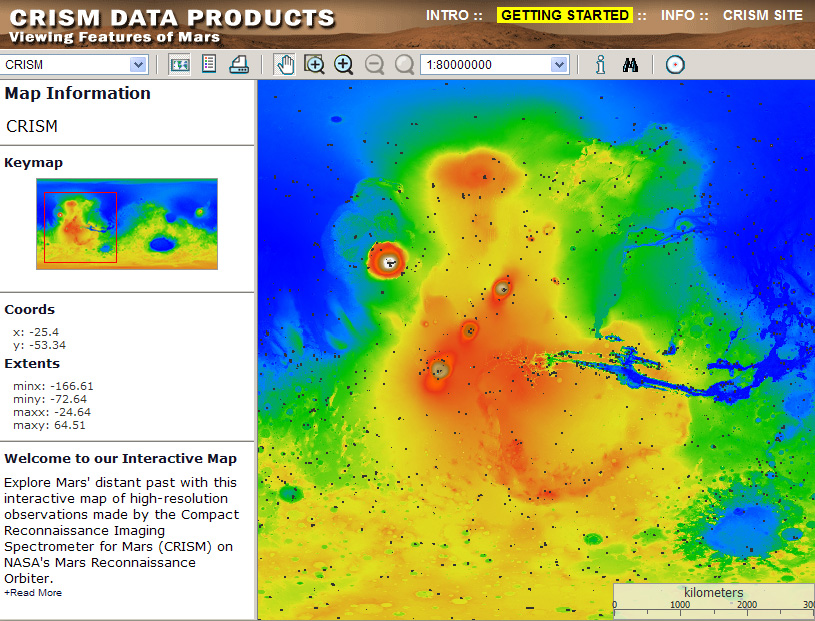Press Release
APL Spectrometer's Coverage of Mars Continues to Grow
An online map showing a collection of high-resolution images from one of the most powerful spectrometers ever sent to the Red Planet continues to grow. The data come from the Compact Reconnaissance Imaging Spectrometer for Mars (CRISM), which was built by The Johns Hopkins University Applied Physics Laboratory, and is on board NASA's Mars Reconnaissance Orbiter. Every three months the CRISM team releases a new batch of data to NASA's Planetary Data System (PDS) and logs them in the online map. The latest release on September 8, 2008, includes 1,575 new images, bringing the total number of released high-resolution images in the digital library to 4,580.
"It's really exciting seeing more and more new areas of Mars in this way," says APL's Frank Seelos, CRISM's science operations lead. "Already researchers have been using the map to preview the data set, find interesting rock outcrops no one had noticed yet, and download and analyze the data from the PDS."
The high-resolution map can be found on the "CRISM Data Products: Viewing Features on Mars" Web site, at http://crism-map.jhuapl.edu/, and is best viewed with Firefox 2.0, Netscape 7.2, or Internet Explorer 7.0, or better. Visitors to the site choose from a selection of global background maps made by instruments on NASA's Viking, Mars Global Surveyor and Mars Odyssey spacecraft. They can zoom in, click on particular CRISM observations that dot the maps, and view the multiple versions of each image. If they are interested in the full 544-color data, a link for each image brings them to the data in the PDS.
CRISM's primary mission is to search for signs that liquid water once existed on Mars by identifying minerals that form only in the presence of water. Molecules of water trapped in these minerals leave particular patterns in the sunlight that reflects off of them and into CRISM, which senses up to 544 "colors," or wavelengths, of light. In the online map, these data have been converted into easy-to-understand composite images that show the locations of water and carbon dioxide ice; iron-containing igneous minerals formed by volcanic activity or cratering; iron minerals that have been altered by oxygen in the atmosphere; and clay-like and sulfate minerals that were formed by past liquid water.
The images will also help determine where NASA's Mars Science Laboratory, set to launch in late 2009, will begin roving the planet in its search for traces of organic materials preserved in Mars' rocks. "We've covered all of the areas under consideration as landing sites for the Mars Science Laboratory, and some of them have really spectacular rock formations that we believe will yield interesting information on Mars' past," says Olivier Barnouin-Jha, a member of the CRISM operations team at APL.
As CRISM completes its first Mars year (about 687 Earth days) of observing in mid-November 2008, the total number of high-resolution CRISM images is expected to top 9,000. "The online map is a powerful tool for surveying the CRISM data," says Christopher Hash, CRISM's downlink operations lead. "The total volume of the high-resolution images released to the PDS is already around three terabytes, and that will double once we've delivered all the high-resolution images from the first Mars year. While no one person can look at all of that complex data, in a few days a scientist using the online map can get a high-level glimpse of everything."
APL has built more than 150 spacecraft instruments over the past four decades. NASA's Jet Propulsion Laboratory, a division of the California Institute of Technology in Pasadena, Calif., manages the Mars Reconnaissance Orbiter for NASA's Science Mission Directorate, Washington. Lockheed Martin Space Systems, Denver, Colo., is the prime contractor for the project and built the spacecraft.
The Applied Physics Laboratory, a division of The Johns Hopkins University, meets critical national challenges through the innovative application of science and technology. For more information, visit http://www.jhuapl.edu. For more information on CRISM, visit http://crism.jhuapl.edu.
